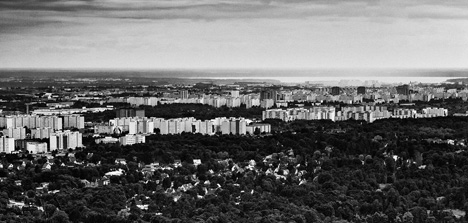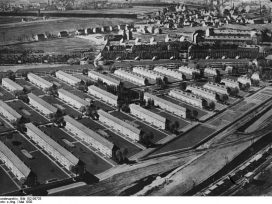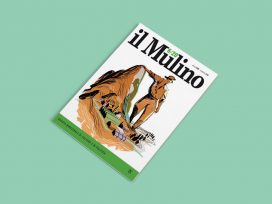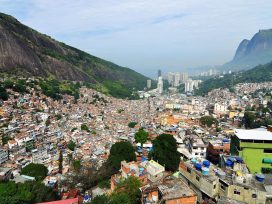What is unnatural? Why do people refer to certain things as unnatural? And how does this reference configure their relationships to other humans and the wider world? This article explores how the concept of the “unnatural” emerges and is used in different contexts, and what consequences it has politically, socially and culturally.
Much has been written about the concept of “nature”, while its polar opposite has largely remained in the shadows of scholarly attention. However, in an age where the natural has been declared obsolete as a substantive category (e.g. McKibben 1989, Sayre 2012), it may be high time to inspect its antonym more closely. For the unnatural is an immensely powerful, if inherently ambiguous, concept with critical implications for the formation of social categories, the morality of classifications, the terms of urban governance and the directions of environmental conflicts. What is considered unnatural is a question of framing, strategizing, and of the significance of the respective categorical boundaries; its meaning emerges through ongoing and often conflicting ecologies of practice. Furthermore, the construction of the unnatural is so deeply entwined in wider social, political and cultural dynamics that it must not be taken for granted as a foundational circumscription of the subject matter of cultural theory. In other words, cultural theory must not be limited to the “unnatural”, leaving the “natural” to the methods and theories of the natural sciences. In a world where the natural and the unnatural emerge as shifting configurations of matter and meaning, cultural theory is faced with the opportunity to explicitly expand its own frame of reference beyond what the “natural sciences” have left over, to embrace the total spectrum of phenomena in which culture is cultivated.

Lasnamäe, the most populous administrative district of Tallinn, Estonia and a mixture of built environment and green belt. Photo: Raimo Papper. Source:Flickr
In order to overcome the limitations of cultural theory as regards the “unnatural”, we may be well advised to follow recent theoretical developments in the social sciences and humanities. For example, within semiotics, an approach that is often termed “ecosemiotics” analyses communication and meaning-making across species, to present human culture as part of a larger continuum of semiotic processes (Maran and Kull 2014; Kohn 2013). “Ecosemiotics does not build a barrier between human semiotic activities and those of other inhabitants and thus allows research questions to be raised about the whole communicative structure of […] geographical space” (Maran and Kull 2014: 48). Focusing more on agency than on communication, the approach that has become famous as Actor-Network-Theory similarly emphasizes the relationality of life processes, and the dependence of “cultural” phenomena like institutions, markets and knowledge on their successful integration with material elements (Latour 2005b). Also in political theory, scholars like Bennett (2010) have noted how non-humans – and even inorganic matter – play a critical and active role in political processes and power struggles, not just as “objects” of struggles, but as “vibrant” participants in the assemblages that shape and enable polities and politics. Notably, already in 1963, theologian Paul Tillich remarked that the religious significance of the inorganic is immense, although an adequate “theology of the inorganic” was lacking at the time (Tillich 1963: 18-19).
In sociology, the continuity of human and non-human relations has been conceptualized through a social practice approach (Shove et al. 2012; Shove & Spurling 2013), which analyzes practices as enduring social entities, consisting of interdependent elements – bodily activities, mental activities (knowledge, beliefs, motivations, etc.) and the physical environment. By recurrently enacting certain practices, human beings both reproduce and innovate social rules and meanings, and shape their environments. Furthermore, there are on-going discussions in human geography about turbulent, interrogative and excessive materiality, which is perpetually beyond the grasp of humans (e.g. Anderson & Harrison 2010). Hence, recent theoretical and methodological developments in geography have aimed at “reimagining relations between the material, perceptual, affectual, and discursive” (Anderson & Wylie 2009: 332). All these trends suggest that the unnatural – and its relation to culture and cultural theory – must not be taken for granted. Rather, once we recognize forms and meanings as enactments in a context of turbulent materiality, it becomes clear that no phenomenon is inherently natural or unnatural, and no particular disciplinary tradition has exclusive access to any specific part of the world.
Within anthropology, research has long pointed to the problems of attempting to limit the study of culture to the “unnatural” aspects of people’s lives, not only in ecological anthropology (Steward 1955; Ingold 2000), which emphasizes the integration of social and ecological relations, but also in studies of cosmologies (Strathern 1980, Bird-David 1990; Kohn 2013) that problematize the validity of the conceptual pair natural-unnatural as an analytical frame altogether. Recently, anthropologists have begun to write “multispecies ethnographies” (Kirksey and Helmreich 2010) and argued for making “more-than-human sociality” (Tsing 2013) more explicit in description and analysis. Developing cultural theory beyond the “unnatural” also implies radically rethinking the concepts of person and organism, classically the principal units of cultural and biological studies, respectively. Ingold (2013: 10), for instance, argues that “we can no longer think of the organism, human or otherwise, as a discrete, bounded entity, set over against an environment. It is rather a locus of growth within a field of relations traced out in flows of materials”. And Kohn observes:
An anthropology that focuses on the relations we humans have with nonhuman beings forces us to step beyond the human. In the process it makes what we’ve taken to be the human condition – namely, the paradoxical, and “provincialized”, fact that our nature is to live immersed in the “unnatural” worlds we construct – appear a little strange. Learning how to appreciate this is an important goal of an anthropology beyond the human. (Kohn 2013: 42)
Thinking about the unnatural can therefore be seen as an opportunity to explicitly expand cultural theory, beyond a focus on describing and explaining unnatural (human, constructed, imagined, symbolic) phenomena, and towards an exploration of the material-semiotic processes that produce the unnatural and the powerful efficacy of the concept. In what follows, we approach the unnatural from various angles, in order to elucidate complementary aspects of the concept’s efficacy. In these explorations of the unnatural, the concept always emerges out of specific, materially and semiotically situated practices and discourses. The resulting understanding of the unnatural must therefore not be mistaken for a claim to the universality of the concept or its particular set of meanings presented here. Furthermore, in arguing for paying attention to the situatedness of the unnatural, we must be cautious that this arguing is done in a specific language – i.e. the English of early twenty-first century scholarly writing – which itself implies certain webs of meanings in relation to the term “unnatural”. In other languages, this term may be bound up in significantly different webs of meanings, or may not exist as a direct translation at all. For example, we forcefully encountered this difficulty when writing and discussing earlier drafts of this text in Estonian, a language which distinguishes between ebaloomulik (unnatural concerning a deviance from an essence, expectation or habit) and mittelooduslik (unnatural concerning a phenomenon that is not considered part of the natural realm). This caused not only some confusion among us authors, but also an increased alertness to the specificity and potential incommensurability of the concept across linguistic, historical and socio-cultural settings.
Hybridity, cyborgs and monsters
The unnatural tends to emerge through perceived confusion or infraction of categorical essences and boundaries. Such structural models are usually based on Mary Douglas’s (1966) seminal work that defines pollution and dirt as “matter out of place”, i.e. phenomena that disturb a particular conceptual order. Perhaps then, the unnatural should be considered a “residual category” in Douglas’s (1966) sense, as an attempt to describe phenomena that do not fit our general classification system. According to Douglas, this is not merely a cognitive issue, but equally an emotional one. She argues that disgust is a response to a threat to the known and predictable order, the “cherished classifications” (Douglas 1966, p. 45).
Discussions surrounding the cyborg, for example, suggest that it may be especially when basic ontological boundaries – e.g. between different natural kinds (e.g. species) or between human and non-human – are breached, that the unnatural emerges. For example, Leon Kass (1997), an American physician and conservative public intellectual and educator, controversial chairman of the President’s Council on Bioethics from 2001 to 2005, and sharp critic of euthanasia, human cloning and embryo research, categorizes cloning alongside incest, bestiality, and cannibalism, suggesting that like these acts – which arouse horror and disgust by violating the ontological boundary of human and nonhuman – cloning, too, violates this boundary at the expense of valuing human dignity and identity, by making human children into “artefacts”. For this reason, cyborgs and other posthuman hybrids are often seen as figures of the monstrous, moral abominations resulting from the transgression of ontological boundaries. Elaine Graham writes, “just as monsters of the past marked out the moral and topographical limits of their day, so today other similar[ly] strange and alien creatures enable us to gauge the implications of the crossing of technological boundaries” (Graham 2002, 39). If the monsters’ monstrosity is thus a product of a particular representational framing that cannot take account of them, then we can “reorient and regulate the proliferation of monsters by representing their existence officially”, as Latour (1993: 12) writes. Monsters and cyborgs are unnatural as long as the phenomena they embody cannot be easily accommodated into our conceptual framing.
A cyborg is a hybrid figure: neither wholly organic nor solely mechanical, the cyborg is both simultaneously, straddling these taken-for-granted ontological and social categories. One way of describing the cyborg’s defiance of the ontological boundaries is to call it “unnatural”. Donna Haraway (1991: 151-3) identifies three “breached boundaries” represented by the cyborg: human/animal, organism/machine, and (as subset of the second) physical/nonphysical. The human/nonhuman animal boundary is as actively defended as it is breached. That we often feel a need to police the boundary is the direct result and a symptom of the fragility of boundaries. Yet, the cyborg can be seen as a symbol and description for a contemporary mode of existence. The hybridity of the cyborg, as well as its manufactured, technological origin, defy the expectation of a single, given, biologically inherited “nature.” Also in a wider sense, cyborg hybridity calls into question the concept of “Nature” as the determining origin of all biological natures. Again, this has tangible moral implications. Haraway’s (1991) objection to appeals to ahistoric Nature are not only that concepts of nature are culturally constructed and historical rather than timeless and essential, but also that these historical, cultural concepts have not been morally neutral. Rather, they have been damaging and oppressive, employed to reinforce sexism, racism, homophobia, and other forms of infectious fear of the other. At the same time, Haraway resists modern technoscience’s opposite extreme of a “nature of no nature”. This perspective reads nature as a blank slate, infinitely malleable, and available as raw material for the meaning-giving activities of human beings. As Haraway points out, this is simply a reiteration of the old dualism of nature/culture, only without the transcendental – nature without the capital “N”, but nonetheless equally available for human exploitation as infinite resource.
Looking for “a different relationship to nature besides reification and possession”, Donna Haraway (1992b: 296) insists that nature is a socially constructed category, posing as an absolute with the power to dictate permissible social, moral, political, and technoscientific norms and practices. The illusion of naturally given norms appears in many contexts. However, nature is not constructed solely by humans: the construction of nature is a project, a kind of relationship and an achievement undertaken by human and nonhuman agents. Whatever nature is, it is not a simple given, and Haraway’s plea is that we recognize our responsibility in its construction, and our complicity in its destruction. Haraway attempts to dispel the illusion of self-evident necessity surrounding natural discourse wherever it appears: “Queering what counts as nature is my categorical imperative […] not for the easy frisson of transgression, but for the hope of liveable worlds” (Haraway 1992a: 60).
Different kinds of cyborg are all around us. There are those humans who have artificial organs or prostheses, there are those whose creativity is expressed predominantly via technologies, and those who dream of enhancement, military or otherwise. Even to have a concept of cyborg, without literally cyborgic embodiment, makes us different from people who lived perhaps only a few decades ago. Haraway has pointed out that all claims of identity based on a natural or organic standpoint are suspect. Her talk of cyborgs deliberately breaks down the dichotomy between nature and technology, natural and unnatural. The cyborg has no recourse to an imagined organic unity: it requires both the biological and the technological. Our nature is technonature and our culture is technoculture. If we look for nature outside of ourselves and our practices, we may lose both ourselves and nature (Kull 2000).
As Latour (1993) has pointed out, the cyborg represents one side of a coin of twin movements in modern western society. Latour focuses on the relationship between the concepts of nature and of culture, and how the context that he calls “the modern constitution” simultaneously connects and distinguishes them. In order to produce and to deal with hybrid mixtures, the inverse movement of keeping nature and culture separate, which Latour terms “purification”, is equally important. “If we consider hybrids, we are dealing only with mixtures of nature and culture; if we consider the work of purification, we confront a total separation between nature and culture” (Latour 1993: 30). This relationship is also at play in the production of the unnatural. The ongoing work in producing and maintaining a conceptual framework that makes particular phenomena (sexual practices, hybrid life forms, urban structures, etc.) appear as unnatural must be concealed when presenting the framing as factual. As much as an acknowledgement of the “proliferation of the unnatural” (to paraphrase Latour) contributes to a re-evaluation of the cyborg, the parallel process of purification keeps enacting categorial distinction and boundaries, producing new or reproducing old conceptual spaces of the unnatural.
The cyborg, the embodiment of this problematic interrelationship between mixture and separation, between naturalizing and unnaturalizing, draws attention not only to the multi-directional dynamics involved in producing the unnatural, but also to the direct implication of human bodies and identities in questions of the unnatural and its negotiation. Framing the unnatural is thus not only a statement about the order of a world external from us, but includes at its heart a positioning of the human within this world, and of human relationships with organic and technological forms and processes.
Unnatural urban sprawl?
How do different urban planning paradigms use understandings of the unnatural for reconstructing the meanings of “good urbanity”? And how do modernist and environmental sustainable planning paradigms contextualize the unnatural in the urban condition? To exemplify the ambivalence of the unnatural/natural opposition in the context of changing urban paradigms in Estonia, it is thought-provoking to study the landscapes of former Soviet summer cooperatives around the bigger Estonian cities and their transformation into permanent residential areas. Summer cooperatives (known also as dachas) were built by different enterprises for their employees during the Soviet time, from the 1960s to the 1980s. The people used their plots to grow vegetables and erect small non-heated houses for summer residence. Dachas were inhabited only seasonally. After Estonia regained its independence in 1991, in the process of large-scale privatization of formerly state-owned assets, these summer-cooperatives became entangled in the dynamics of urban sprawl, which was often the outcome of an unregulated urbanization process. The land was distributed to the individual members of the cooperatives, who fenced off their pieces of land and often sold them. Urban sprawl was especially intensive during a housing boom in the end of the 1990s and 2000s, when new housing developments extended into the forests, rural landscapes and former dacha areas (Samarüütel et al. 2010).
The main impulses to move from the city into former cooperatives were similar to the general causes of suburbanization, such as desiring one’s own house outside the city and the attraction of greenness. Even though the dacha building standards and aesthetical appearance did not corresponded to popular housing ideals, former summer-home settlements were preferred for permanent living over new suburban settlements because in a summer-home area the price of the plot was cheaper (Leetmaa 2012). These cooperatives were often built in vernacular architecture, which at one time followed construction plans but changed its appearance in time according to necessity, resulting in an improvised or untidy appearance. Such architecture is still in place where initial summer-home owners have not rebuilt or sold their plots. This somewhat messy and wild aesthetic is partly changing, because for new suburban owners it is more economical to build a completely new house instead of renovating or rebuilding the former summer-home. Permanent residents’ gardening practices differ from those of the former summer-time residents in that permanent residents prefer lawns to a vegetable garden. Some gardening cooperatives are located on peat soil, and because of spring and autumn floods the houses need to be built on raised platforms, the roads need continuous maintenance and the gardens need more caretaking. With the transformation from summer colonies to suburban neighbourhoods, municipal infrastructure like roads, water and sewerage systems are provided, which raise the prices of the plots.
This transformation from garden cooperatives into permanent residential areas accords with modern strategies of urban planning and approaches to greenness and nature, where urban sprawl is considered a natural outcome of urbanization processes. The transformation points to the lack of environmentally friendly residential urban areas, but paradoxically, in the process, more and more rural areas are domesticated by urban lifestyles (see Cadieux 2008). In a socio-ecological planning system where an ecologically oriented urban paradigm dominates, urban sprawl would be reversed and perceived as unnatural. These former garden cooperatives in their previous condition would already constitute examples of a new urbanity.
Claiming responsibility
To call something unnatural infers that it has been altered from its original or essential state, most probably by human action. By pointing to this human manipulation, people also bring this alteration into the social realm of exchange, ethics and responsibility. Most often, an unnatural phenomenon has an author, producer or transgressor behind it, someone who can be held responsible for an unnatural phenomenon with negative consequences, or can claim credit for one with consequences that are considered beneficial. For instance, if a seed variety can be proven to be different from its natural kind, its producer can claim ownership of the “unnatural kind”, and may even register a patent and seek compensation for the subsequent use of the variety (e.g. Fowler 1994, van Dooren 2008). Conversely, events like hurricane Katrina have been called “unnatural disasters” (e.g. Levitt and Whitaker 2009) to highlight the fact that floods, earthquakes and other hazards would be much less harmful had they happened in a “natural” rather than “unnatural” manner, i.e. if vulnerabilities had not been increased through specifically human acts. We shall illustrate this use of the unnatural by referring to two water engineering projects, on the Murray River in Australia and on the Zambezi River between Zambia and Zimbabwe. Both cases illustrate that declaring something “unnatural” amounts to assigning (or looking for) a human actor responsible for it; declaring it “natural” respectively equals denying (or at least playing down) human agency and responsibility in relation to the phenomenon.
David Hughes (2006) documents the process of redefining the hydropower reservoir on the Zambezi known as Lake Kariba from an environmental catastrophe to a conservation site between the 1950s and 1980s. Focusing on representations of the water body in literature by white authors, Hughes traces the stylistic and metaphoric means that were used to highlight the naturalness of the reservoir and sideline its engineered artificiality. They include allusions to the “water heritage” of the British-origin settlers in a predominantly dry country, the establishment of various parks, safari areas and nature reserves along the affected river stretches, references to the biblical flood and an “Operation Noah” designed to safe some of the area’s animals threatened with drowning, and the likening of the present reservoir to an alleged ancient geography of Africa (turning an engineering intervention into an act of ecological restoration). By the late 1970s, the reservoir and its environs were described as a “wilderness”, where “man […] has come to terms with Nature and Nature, perhaps, with him” as a contemporary writer put it (quoted in Hughes 2006: 836). In this colonial context, the reservoir that “displaced 57,000 Tonga-speaking inhabitants of the Zambezi Valley, killed all but a fraction of the animals and drowned all plant life” (Hughes 2006: 823) was “redeemed” as a feature of natural beauty by white settlers with British language and landscape imaginary, rendering Tonga inhabitants, their language, landscapes and interests invisible. The naturalising of the reservoir thus rid the colonial power of its responsibility of destroying tens of thousands of livelihoods, killing animals and plants and radically changing the hydrological regime of the Zambezi River.
Emilie O’Gorman’s (2010) account from the Australian Murray River in the 1950s speaks of the flip side of the same relationship. An increasing number of affected people attributed recurrent floods to the expanding irrigation schemes in the catchment, claiming that these floods were “unnatural”. Especially dairy farmers, whose land and animals were threatened by changing hydrological dynamics, blamed these changes on the problematic operation of dams, including a scheme that was to divert water from a neighbouring catchment into the Murray. The dams, they argued, not only brought more water into the river in general, but were managed specifically for the benefit of irrigated agriculture rather than for the overall population in the catchment. Interested in full reservoir capacity whenever possible, this management priority was accused for increasing flood risks instead of using the dams in flood defence. While later research concluded that the dams did not directly increase floods on the Murray, but that these floods were the result of higher-precipitation years, the argument of a river turned “unnatural” by hydro-engineering and causing “unnatural” floods was very powerful at the time.
Greater government involvement in river flow through these centralised organisations [River Murray Commission and Snowy Mountains Hydro-Electric Authority] and dam construction and operation had made them responsible for the river in many people’s eyes. Dam construction had altered the river and changed what were previously seen as natural systems. As a result floods were no longer natural disasters in the way they had been and were instead seen to come from a river controlled by officials. (O’Gorman 2010: 102)
The relationship between the unnatural and the political is key in these contexts. As Bruno Latour (2004a, b, 2005a) has argued, assuming the existence of a sphere of nature defined and judged by scientific experts precludes most of democratic debate, as it reduces decision processes to mere technical calculations based on known and clear facts. He asserts that “nature is the chief obstacle that has always hampered the development of public discourse” (2004a: 9). The problem, Latour explains, lies in taking the factuality of nature, as an essential realm of existence inaccessible to ordinary human beings, for granted, and opposing it to a politics conceived as a second-order phenomenon that can only debate opinions and representations, rather than proper facts. Conceptualising nature as “matters of fact’ only allow for an undemocratic realpolitik (Latour 2005a); speaking about the unnatural, however, means acknowledging and taking to heart the human involvement with these things, turning them into “matters of concern” that open up a dingpolitik where the continuity of facts and values is acknowledged, and fundamental political debate possible. On the Murray, the inaccessible, factual sphere of expert-defined nature was pried open by the claim that the river and its floods were unnatural, thus simultaneously making space for political debate about responsibilities, different discharge regulation regimes, and state priorities for economic development. On the Zambezi, conversely, initial debates about the violence of the reservoir (and its champions) were closed down by redeeming it as a scene of natural beauty.
To sum up, the concept of the unnatural implicates a series of claims, not only about what is (un)characteristic, (not) according to laws of nature, and (outside of) a realm of real, material phenomena, but also about authorship and responsibility. Designating something as unnatural is tantamount to looking for or identifying a human actor responsible for it, and to opening up a political debate about the distribution of its costs and benefits. Furthermore, these examples indicate that human meaning-making must not be considered a unilinear development, where “new” phenomena are first considered “unnatural’, and are gradually, through processes of domestication and integration, re-signified as “natural”. Rather, the examples mentioned here suggest that re-signification processes are socially and politically situated, and may proceed both ways, including labelling a formerly “natural” phenomenon as “unnatural”. What is called unnatural therefore not simply describes things or practices that are foreign to a given arrangement of meanings or cross crucial categorical boundaries; but the unnatural also emerges creatively out of strategic uses by particular political actors who foreground or downplay certain categories and meanings to forcefully make a statement.
Conclusion
Exploring how the unnatural emerges and is used, this article has highlighted aspects of the concept and its efficacy in social and cultural life. Structurally, the unnatural exists as a derogatory or dangerous “non-category” beyond or between more clearly defined categories. It is precisely through this beyond-ness and between-ness, and the concomitant impossibility to semiotically pin it down or domesticate it, that the unnatural gains its power as a label. In order for people to recognize “monsters” or “cyborgs” as unnatural, their perception needs to conform to a particular framing that excludes or divides just those phenomena. At the same time, the moral implications of the unnatural – as something wrong, abnormal or inferior – work to police and maintain this particular framing. The morality and politics of the unnatural therefore sustain not only a particular social and cultural order, but also a certain conceptual framing that labels deviant categorisations as unnatural.
It has also become clear, however, that these categories and their framing are not over and above social life, but are constantly enacted, interpreted, challenged, defended – and changed. Furthermore, this performance of categories is not a purely “cultural” matter, but it happens in correspondence with various non-human processes, including those of different materials, plant growth, animal movements and the weather. Finally, this chapter has indicated that the performance of the unnatural embodies a claim that assigns responsibility for the unnaturalness of a phenomenon, and for its consequences. The unnatural thereby becomes a way of raising “matters of concern” out of a factual, un-cultural, pre-social nature, focusing on the relationships of its co-production and opening it up for debate. In the light of social practice, the unnatural emerges as a relatively flexible container with a powerful message, which different groups of people employ creatively to make sense of their position within a multifaceted and polysemantic world.
Inspired by Harraway’s political project, this may trigger further conclusions: for reconceiving our ontologies and epistemologies it is necessary to de-naturalize all of our narratives of Nature. It does make a difference how we write and theorize the type and kind of relations between the various actors and actants called upon in producing and talking about Nature. The Darwinian revolution – the hypothesis that existing nature is sufficient to account for its own intricate organization – already unexpectedly and convincingly animated the whole world’s historical and material complexity: nature became seen as full of dynamic actors and was no longer conceptualized as a receptive or passive resource in the singular. Unpacking the natural as well as the unnatural is a prerequisite for the refusal to credit Nature as the main source for political and social identity.
References
Anderson, B., Harrison, P. 2010. “The promise of non-representational theories”. In Anderson, B. and Harrison, P. (eds), Taking-Place: Non-Representational Theories and Geography. Ashgate, Farnham, 1-37.
Anderson, B., Wylie, J. 2009. “On geography and materiality”. Environment and Planning A 41: 318-335.
Bennett, J. 2010. Vibrant Matter: A Political Ecology of Things. Duke University Press.
Bird-David, N. 1990. “The giving environment: Another perspective on the economic system of gatherer-hunters”. Current Anthropology 31, no. 2, 189-96.
Cadieux, K. V. 2008. “Political ecology of exurban ‘lifestyle’ landscapes at Christchurch’s contested urban fence”. Urban Forestry & Urban Greening 7, 183-94.
Douglas, M. 1966. Purity and Danger: An Analysis of the Concepts of Pollution and Taboo. Routledge.
Fowler, C. 1994. Unnatural selection: Technology, Politics, and Plant Evolution. Gordon and Breach.
Graham E, L. 2002. Representations of the Post/Human: Monsters, Aliens and Others in Popular Culture. Rutgers University Press.
Hankins, K. B, Powers, E. M. 2009. “The disappearance of the state from ‘livable’ urban spaces”. Antipode, 41, no. 5, 845-66.
Haraway, D.J. 1991. Simians, Cyborgs, and Women: The Reinvention of Nature. Routledge.
Haraway, D.J. 1992a. “When Man™ is on the Menu”. In: Crary, J. and S. Kwinter (Eds.), Incorporations. Urzone, 39-44.
Haraway, D.J. 1992b. “The Promises of Monsters: A Regenerative Politics for Inappropriate/d Others”. In: Grossberg, L., Nelson, C. and P. Treichler (Eds.), Cultural Studies. New York: Routledge, 295-337.
Hughes, D. M. 2006. “Whites and water: How Euro-Africans made nature at Kariba Dam”. Journal of Southern African Studies 32, no. 4, 823-38.
Ingold, T. 2000. The Perception of the Environment: Essays on Livelihood, Dwelling and Skill. Routledge.
Ingold, T. 2013. “Prospect”. In: Ingold, T. and G. Pálsson (eds.), Biosocial Becomings: Integrating Social and Biological Anthropology. Cambridge University Press, 1-21.
Kass, L. 1997. “The wisdom of repugnance”, The New Republic, 2 June 1997, 17-26.
Kirksey, S. and S. Helmreich. 2010. “The emergence of multispecies ethnography”. Cultural Anthropology 25(4): 545-76.
Kohn, E. 2013. How forests think: Toward an Anthropology Beyond the Human. University of California Press.
Kull, A. 2000. A Theology of Technonature Based on Donna Haraway and Paul Tillich. Ann Arbor, Michigan: UMI Dissertation Services.
Latour, B. 1993. We Have Never Been Modern. Harvard University Press.
Latour, B. 2004a. Politics of Nature: How to Bring the Sciences into Democracy. Harvard University Press.
Latour, B. 2004b. “Why has critique run out of steam? From matters of fact to matters of concern”. Critical Inquiry 30, no. 2, 225-48.
Latour, B. 2005a. “From realpolitik to dingpolitik: Or how to make things public”. In Latour, B and Weibel, P. (eds.) Making Things Public: Atmospheres of Democracy. MIT Press, 14-43.
Latour, B. 2005b. Reassembling the Social: An Introduction to Actor-Network-Theory. Oxford University Press.
Leetmaa, K., Anniste, K., & Nuga, M. 2012. “Socialist summer-home settlements in post-socialist suburbanisation”. Urban Studies, 49, no. 1, 3-21.
Levitt, J. I., & Whitaker, M. C. (Eds.). 2009. Hurricane Katrina: America’s Unnatural Disaster. University of Nebraska Press.
Maran, T. and K. Kull. 2014. “Ecosemiotics: Main principles and current developments”. Geografiska Annaler: Series B, Human Geography 96, no.1: 41-50.
McKibben, B. 1989. The End of Nature. Anchor.
O’Gorman, E. 2010. “Unnatural river, unnatural floods? Regulation and responsibility on the Murray River in the 1950s”. Australian Humanities Review 48: 87-107.
Samarüütel, A., Selvig, S. S., & Holt-Jensen, A. 2010. “Urban sprawl and suburban development around Pärnu and Tallinn”. Norsk Geografisk Tidsskrift – Norwegian Journal of Geography, 64, no. 3, 152-61.
Sayre, N. F. 2012. “The politics of the anthropogenic”. Annual Review of Anthropology 41, 57-70.
Shove, E., and Spurling, N. (eds.) 2013. Sustainable Practices: Social Theory and Climate Change. Routledge.
Shove, E., Pantzar, M. and Watson, M. The Dynamics of Social Practice: Everyday Life and How it Changes. Sage, 2012.
Steward, J. H. 1955. Theory of Culture Change: The Methodology of Multilinear Evolution. University of Illinois Press.
Strathern, M. 1980. “No nature, no culture: The Hagen case”. In: MacCormack, C. P. and M. Strathern (eds.), Nature, Culture and Gender. Cambridge University Press, 174-222.
Tillich, P. 1963. Systematic Theology. Volume III. Chicago University Press.
Tsing, A.L. 2013. “More-than-human sociality: a call for critical description”. In: Hastrup, K. (Ed.), Anthropology and Nature. London: Routledge: 27-42.
van Dooren T. 2008. Inventing seed: The nature(s) of intellectual property in plants. Environment and Planning D: Society and Space 26, no. 4, 676-97.







